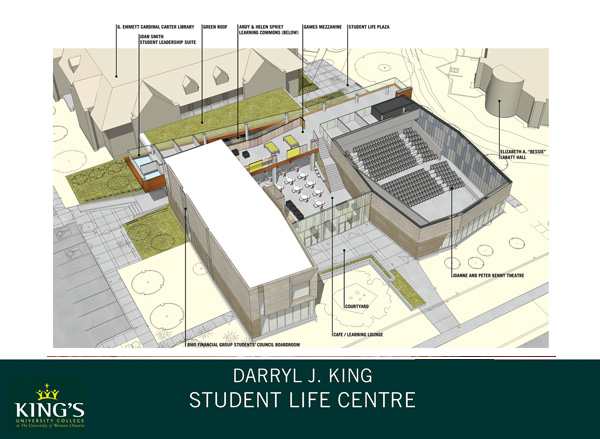The learning commons isn’t the sort of place universities had even 10 years ago. Architects have designed the area as a response to changes in how courses are delivered and how information is consumed.
“The way students are learning today and interacting, they’re on their phones and iPads and laptops and they tend to oscillate very quickly between social behaviour and research behaviour,” said architect Andrew Frontini, a principal at Perkins and Will. “It’s almost at the toggle of a mouse, or the flick of a switch.”
The learning commons will be connected to the library and take some of the pressure off this central study space on campus, said Sylvester.
“Walk by (the library) on any day and you probably can’t find a seat in it,” said Sylvester.
The new building isn’t just the dream of administrators or big donors. Students themselves recently contributed $2.4 million toward the building. The college has also committed to upgrading the energy efficiency and environmental footprint of the building to LEED (Leadership in Energy and Environmental Design) silver and perhaps LEED gold standards, said Frontini.
“At a college of Christian foundations, there’s an ethical and moral sense that we should be mindful of the environment,” Frontini said. “Those ideals were there.”
There are other ideals wrapped up in the new building, according to Sylvester. Like all Catholic colleges, King’s is trying to impart a Catholic intellectual tradition that can trace its roots back to the Benedictine monasteries of the early Middle Ages. To do that it has to preserve and protect a particular atmosphere and promote a focus on undergraduate learning.
But it’s doing that even as the Association of Universities and Colleges of Canada has conceded the undergraduate experience is under strain. The AUCC met in Halifax last March for what it described as “a frank discussion about the current state of undergraduate education.”
That meeting was pushed by small, liberal arts colleges — particularly Catholic colleges — said Sylvester.
“As a whole, the Canadian post-secondary education system had been tipping to graduate studies, largely because that’s where the government money had been flowing,” said Sylvester. “We said we’re out of balance here.”
As class sizes have ballooned and universities have poured money into research and new buildings, the worries of undergraduates have multiplied, said Sam Andre, executive director of the Ontario Undergraduate Student Alliance.
“We have a lot of concerns about affordability, a lot of concerns about teaching quality,” Andre said. “But in addition to that, there’s a huge demand for space.”

A bird’s-eye view of the new Darryl J. King Student Life Centre which will open on the King’s University College campus in the fall of 2013.
Graphic courtesy of Perkins and Will
While new buildings are necessary, they’re not the first concern of students, he said.
“Students are primarily concerned about the experience they have in the classroom and how they’re supported outside of the classroom,” said Andre. “More attention and more resources need to be dedicated to teaching quality, training of professors, that kind of thing.”
Andre’s got a friend in Sylvester. The King’s principal thinks a Catholic education can’t happen without a community, nor without professors committed to that community.
“A relationship with a faculty member, a mentoring kind of relationship, is key to all education, especially at the post-secondary level,” said Sylvester.
The new building is just one attempt to get everybody at the college talking to one another.
“What happens in the informal spaces is absolutely essential to the kind of education that we provide here at King’s, which is an education of the whole person,” he said. “It’s that kind of space where real relationships are built and real knowledge is communicated.”
Sylvester doesn’t see the relationship between undergraduates and professors in terms of wise elders downloading information into the heads of unformed youth. Whether it’s international service learning which sends students to countries and situations they otherwise only read about or student-led seminars, King’s expects students to be leaders.
“We’re asking our students to be researchers and we’re asking our students to be teachers in their own way,” he said.
The buzzwords for this are “outcome-based education,” according to the AUCC. Sylvester thinks that’s what Catholic education has always been about.
“You should be able to meet a student from King’s five years from now and say ‘Ah-ha! That’s one of ours,’ ” he said. “Guess what? They can read, write, speak and they’re citizens of this country and they’re faithful people. They’re not afraid to advocate for a spiritual dimension to life for themselves, for their community and frankly for their country.”
Getting a building that lives up to those ambitions isn’t easy for Catholic colleges in Canada, said Sylvester.
“This is not the United States. In Canada we fight for every donation we get,” he said.
And it all comes down to donations.
“We don’t access (provincial government) capital funding,” said Sylvester. “The resources available to undergraduate Catholic liberal arts colleges across this country are limited, often much more limited than they are for non-denominational institutions.”
More and more Sylvester finds donors willing to listen to his message about the value of a faith-based liberal arts education.
“It’s not just alumni. There are others who see the need for what we provide to Canadian society,” he said.
There’s more to it than just a professor in the classroom and a book in the library.
“An integrated student life costs money.”
Sylvester makes no claim that what King’s is doing is unique. As president of the Association of Catholic Colleges and Universities in Canada he’s seen how all 20 Catholic institutions across the country have struggled to keep up with the demands of students.
“If you visited Catholic colleges across Canada, they’re not the shiniest places,” he said.
“They’re intellectual jewels for this country.”
